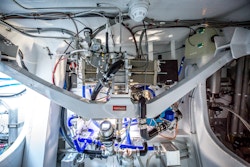The Energy Observer Fuel Cell
The fuel cell is the centrepiece of the hydrogen chain. It converts the hydrogen into electricity by reversing the electrolysis process. The system on Energy Observer was tailor-made by CEA-Liten engineers and provides 20 kW of pure electric power.

A fuel cell associates hydrogen (H2) and oxygen (O2) to form water molecules (H2O), and at the same time, generates electrical and thermal power...with no greenhouse gas (CO2) or fine particles, only water. There are several different technologies for fuel cells. The most widespread used in vehicles is called PEM (proton exchange membrane), because it is compact and has proven to be reliable. It is also the technology used on Energy Observer. It was custom-built to be constantly modified, put to the test and optimised, and to fit in the tight space in a starboard hull.

The CEA-Liten fuel cell
To optimise, a passive recirculation system, using ejectors, recovers unconsumed hydrogen evacuated by the cell and re-injects it, without having to add a pump. Amongst the innovations created for Energy Observer, a system of coal filters protect the cell air input from sea salt. The experience gained with this system will benefit future hydrogen-powered crafts.
In 2018, the Energy Observer fuel cell operated for 371 hours.
During navigation, average daily use was 6 to 7 hours with 48% power output. One of the objectives for 2019 is to optimise cell output by up to 65% by trying to recover the heat it generates, amongst other aspects.